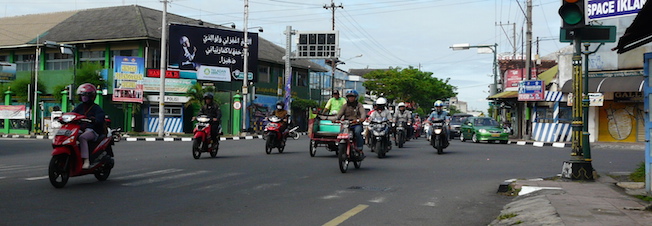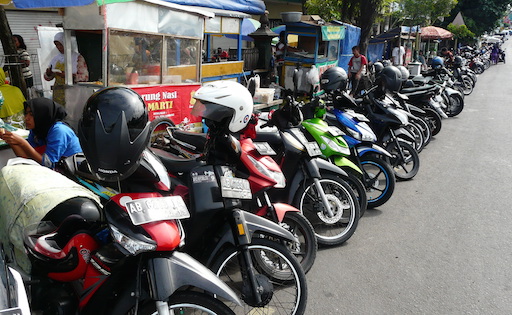Those who have been to Asia know what the traffic is like: Uncountable motorbikes swivel their way crisscrossing through traffic in the narrow streets, rickshaws moving at a snail´s pace amidst the motorbikes. At the roadside a peddler pushes along a foodstall, trying to pass people whom are unloading goods from a parked truck a few meters away and somewhere in between all that are a few cars driving to their destination. Without looking out for traffic, cyclists turn from the street side onto the main road and merge into the slowly flowing crowd.
For Non-Asians, especially people from Europe or Northern America, these conditions appear quite chaotic. And many wonder how on earth do Asians manage to not crash into each other every few meters? (This, by the way, is indeed a miraculous truth: The number of traffic accidents is not proportionally higher than in i.e. European countries.)
The answer is that Asians follow 2 important rules. These rules do not only ensure a safe travel from A to B, but they also help people navigate in vividly diverse environments in general –be it on Asian streets or in the culturally diverse settings of global business. Sounds confusing? Let´s have a look!
Rule #1: Realize that your rules are truly your own…
…and not necessarily rules of others. Regardless of traffic laws, every culture has its own rules, major or minor, of how people ideally get along with each other. These rules are, for example, how we greet people, through which actions we show respect to others or what agenda an office meeting should follow.
However, when working with people from different countries or cultures we are met with a different set of rules. Sometimes these rules don´t reveal itself within a moment’s instance and it’s quite possible that they don´t even make sense to us. Unfortunately, this gives reason to quite a few international professionals to label a foreign culture as “irrational”, “inscrutable” or “chaotic”. But that´s neither fair nor culturally competent: Because by doing so, those professionals interpret a different culture by simply using their own rules.
That´s why in global business it is essential to always keep in mind that colleagues or business partners from different cultures might follow different standards. Instead of assuming that your colleague is not processing a certain job in the way you would do, you can ask yourself critically if your way is also her/his way? Does she/he probably know a different way that could lead to the same result? Self-awareness is the first step towards and also the key to cultural competent thinking and behavior.

Back to the Asian traffic: If you stick to your right of having priority simply because you drive on the main road, you may crash into another vehicle at the next side street. Why? Because not all share your opinion that drivers on the main road automatically have the priority right-of-way. In Asia there seems to be an unwritten rule that drivers from a side street have the right to merge with the main road traffic without waiting for it to pass.
Rule #2: Negotiate it instead of fighting it
How do Asians manage to avoid crashes in such “chaotic” traffic? The reason is according to Rule #1 that they don´t insist on their priority right-of-way and #2 that they negotiate in every critical situation. For example, if a swift motorbike cuts into one´s way, Asians without turning a hair simply adjust flexibly to the situation and find another track on the road to go on. In Asian traffic people negotiate their individual tracks ALL THE TIME, in my opinion approximately 50 times per minute. That´s why for them it is also no problem to deal with a vehicle that moves towards them from the opposite direction amid the crowded traffic…
Instead of insisting on our right-of-way and to define what is right and what is wrong in a certain situation, we first can find out what the others may consider as right or wrong.
It´s similar when working with people from different cultures: Instead of insisting on our right-of-way and to define what is right and what is wrong in a certain situation, we first can find out what the others may consider as right or wrong. On this basis, all people involved can negotiate their positions and find together a way to proceed in cross-cultural situations.
For example, before Germans are starting a team meeting with the urge to get to the point directly and quickly, they could discuss about how to create the agenda for the upcoming meeting with their Asian team members. Then, the Asians would get the chance to share their customs of conducting meetings (that differ quite a lot from the German´s). Maybe they might start with sharing some personal stories or discussing minor office issues before getting down to the serious points.

By doing so, we are able to avoid cultural conflicts. And through negotiating cultural positions – explaining each other´s viewpoints, telling about our values and experiences – we also gain deep insights into culturally different ways of thinking and behaving. These do not only open our minds (a process that every global employee should go through). Through the negotiation process itself we also show respect towards colleagues and business partners from different cultures. We create an appreciative and positive atmosphere in our business relations that will be replied with trustful relationships – no matter which part of our globe.
Negotiating positions and adjusting flexibly to conditions of diverse environments is an everyday job global employees need to become accustomed to. The Asian traffic offers an excellent ground for practicing this.




 Just
Just